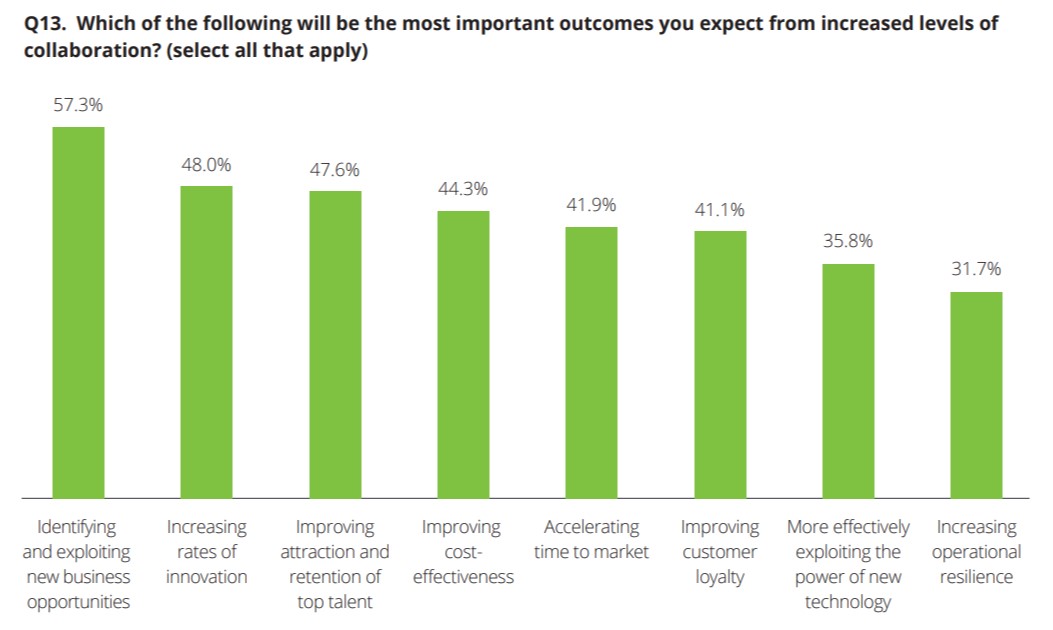
As we enter the third year of a global pandemic, leaders are faced with embracing a new normal. In 2022, we’re seeing new, hybrid ways of working, new expectations from employees, a workforce grappling with mental health and well-being, and an ever-evolving business landscape.
So, what are the skills and traits of successful leaders in this environment? We spoke with Cigna Corporation leaders to get their takes. Read on for four key skills and traits leaders need in order to be successful in 2022 and actionable insights on how to build them.
Empathy Must Be Front and Center for Leaders
Empathy is the ability to understand and experience what others are feeling and to actively share emotions. For leaders, the ability to demonstrate empathy in the workplace is more important now than ever, particularly when it comes to the mental health and well-being of their people. Research from Cigna and the Economist found that 38% of employees and executives surveyed rank fatigue, stress, and burnout as the largest barriers to business success today.
While it is clear that leaders must be empathetic when it comes to the mental health and well-being of their teams, research shows that they often struggle with empathy. According to one study, the percentage of teams with low morale more than doubled during the pandemic, with over half of respondents indicating that their leaders fail to acknowledge employees’ stress or work burnout. And there’s a real business case for empathy in the workplace. A study by Catalyst found that empathy in leadership leads to positive outcomes in the workplace by spurring innovation, driving engagement, and improving work-life balance. Sixty-one percent of workers who experienced empathy from their leaders reported being more innovative, 76% reported they were more engaged, and 86% felt they were able to achieve a work-life balance.
“Empathy must be front and center when developing leadership skills,” said Hollie Ward, vice president of enterprise learning and development at Cigna. “Many key leadership traits and skills – active listening, self-awareness, trust, and transparency – stem from the ability to practice empathy when leading people and teams.”
“Leaders must strive to make every employee feel a sense of belonging so they are able to reach their fullest potential.”Hollie Ward, vice president of enterprise learning and development at Cigna
At its core, this means developing leaders who create genuine connections and really listen to their teams, making them feel heard and understood, she said.
Ward also said that the good news is that empathy, specifically the ability to practice empathy in the workplace, is a skill that can be learned and developed. She offered three tips leaders can use to begin practicing empathy today.
1. Lead by example
The best way to incorporate empathy into the workplace is to lead by example. Leaders must actively practice openness and honesty with their teams, be vulnerable, and encourage others to do the same. When leaders make an effort to share experiences, both good and bad, they provide their teams with the opportunity to better understand decisions and priorities.
2. Embrace one-on-one interaction
Leaders should strive to create genuine connections with individuals, one on one. Every employee has a unique perspective, life experience, and way of operating. By taking the time to understand key goals, drivers, and expectations, leaders can tailor their style to best improve team outcomes and ensure people are heard and understood.
3. Encourage opportunities for open dialogue
Open dialogue can help cultivate an inclusive environment. Leaders cannot truly understand the needs of their team if employees feel uncomfortable sharing their perspectives. Leaders should actively look for opportunities to foster open dialogues, either informally or formally.
Leaders Must Embrace Technology and Digital Ways of Working
If we’ve learned anything from the past two years, it’s that business priorities and ways of working will continue to evolve and change at a rate faster than ever before. Leaders must adapt to new, hybrid ways of working and stay ahead of innovative and disruptive trends. It is crucial that leaders embrace change and set an example, particularly when it comes to new tools and technology.
PwC predicts that one in three jobs is likely to be severely disrupted in the next decade because of technological change, and nearly half of CEOs plan increases of 10% or more in their long-term investment in digital transformation. Importantly, PwC also found that employees are eager to learn new digital skills and have proven their ability to quickly adapt to a changing environment.
The PwC survey also found that 40% of workers successfully improved their digital skills during the pandemic and that 77% are ready to learn new skills or retrain completely. In addition, 51% think technology breakthroughs will transform the way people work over the next three to five years.
“This year, I’d like to see leaders lean into an experimentation mindset and invest in test-and-learn digital approaches for both themselves and their teams.”Katya Andresen, chief digital and analytics officer at Cigna
Andresen outlined three recommendations for leaders in 2022:
1. Embrace digital disruption
Leaders need to be embracing a digital-first mindset. A positive outcome we learned from the pandemic is that when given the chance, people proved they could transition quickly to remote work while keeping productivity high. The same is true for new tools and technologies: Leaders should embrace unfamiliar ways of working to find a competitive advantage to better serve their employees and, ultimately, their customers.
2. Experiment, experiment, experiment
Leaders should adopt a “fail fast” approach to new tech. Whether it is a new project management tool to improve team efficiency, a new collaboration tool to spark innovation, or a fully scaled customer-facing product, digital is grounded in data, which can be used to quickly and more intelligently make decisions or predict new outcomes. If something isn’t working, leaders can efficiently pivot to new solutions, working with more agility in large, matrixed environments.
3. Foster development within your team
Technology and digital skills don’t have to come from the top down. As a leader, encourage your team to brainstorm new ways to innovate or create efficiency with digital tools – and learn from them. Actively survey your team to identify gaps or needs within the team, and challenge them to find digital solutions.
Leaders Must Help Teams Build Resilience
As the workforce grows weary after the latest wave of pandemic related challenges – record-breaking omicron transmissibility, new waves of school closures, the need for frequent COVID-19 testing – leaders will continue to be tested in their ability to bounce back from adversity and help their teams continue to deliver value and find balance in the workplace.
“In 2022 and beyond, a defining characteristic of leadership must be resilience.”Dr. Doug Nemecek, chief medical officer at Evernorth, Cigna Corporation’s health services business
"Leaders must shift their focus to help their teams build resilience, strengthening their resolve to overcome new, unforeseen obstacles,” Dr. Nemecek said.
Resilience is defined as our ability to quickly recover from challenges. According to the Cigna Resilience Index, this trait is at risk in three in five people in America. For leaders, the ability to build and maintain resilience in themselves and others is crucial. Cigna’s research found that workers with low resilience have lower job satisfaction and higher likelihood for turnover, lower performance and professional ambition, weaker relationships and lack of community at work, and lower feelings of self-worth and self-esteem.
Dr. Nemecek noted that it is important for leaders to understand the underlying factors that contribute to resilience. Diverse groups and teams are significantly more likely to be resilient, he said. Mental and physical health and sense of community are also linked to resilience. Good physical and mental health can drive higher resilience, as can social connectivity and support – a feeling of belonging and equal treatment and access to resources and tools like community support programs and employee assistance programs.
How can leaders help build resilience for their teams in 2022? Dr. Nemecek offered three actionable insights from the research.
1. Increase transparency
Leaders must build transparency and two-way communication into the culture of their team. Workers who have frequent and proactive conversations at work with managers and leadership, including difficult topics, have higher resilience. Workers who are frequently able to talk through problems with their coworkers are more likely to be resilient than those having these conversations infrequently (48% vs. 31%).
2. Promote availability of access to resources and tools
Workers who have access to resources such as employee resource groups and paid parental leave, as well as resources that help manage COVID-19 stressors, are more likely to be resilient. And workers with access to expanded mental health services are more likely to be resilient than those without access. Leaders must take an active role and become advocates for these resources, helping ensure their teams are taking advantage of available resources – inside or outside of an organization.
3. Encourage social connectivity and reward support at work
Research shows that team building and positive workplace relationships have a significant impact on levels of resilience. In 2022, leaders must find ways to foster this connectivity in order to build more resilient teams. Nearly four in 10 full-time workers (39%) who have good relationships with their coworkers are considered to have high resilience, compared to just 11% with fair or poor coworker relationships. Furthermore, workers who agree that their coworkers are supportive of them are more resilient (40%) than those without supportive coworkers (14%).
Leaders Must Work To Reshape Collaboration in 2022
According to research by Gensler, the pandemic has dealt a significant blow to collaboration. Before the pandemic, U.S. workers spent an average of 43% of their workweeks collaborating virtually or in person. Collaboration time fell to 27% for workers who worked from home in 2020. In 2022, tools and technology will undoubtedly improve our ability to collaborate and connect in a hybrid environment, making collaboration an important trait for leaders.
When asked about his professional Near Year’s resolution and his thoughts for 2022, Everett Neville, executive vice president of strategy, corporate development, and solutions at Cigna, said collaboration is key to business success.
“Tunnel vision and organizational silos won’t get us very far at a company with more than 70,000 employees worldwide.”Everett Neville, executive vice president of strategy, corporate development, and solutions at Cigna
“Cohesive alignment across our multitude of departments is going to be mission critical for us to truly improve the health, well-being, and peace of mind of those we serve,” he said.
According to a white paper by Deloitte, C-suite executives agree that a wide variety of positive outcomes come from increased levels of collaboration.
When asked which will be the most important outcomes from increased levels of collaboration, executives indicated identifying and exploiting new business opportunities (57%), increasing rates of innovation (48%), and improving attraction and retention of top talent (47%) as top expectations from increased collaboration.

Source: Deloitte
Looking ahead to 2022, how can leaders foster collaboration? Neville shared two insights.
1. Foster “thought partnerships”
In order to break down silos, which can hinder innovation and solutions, leaders can establish thought partners from across business lines and functions. Very rarely does a single individual come up with an idea out of the blue that works as a solution. The goal of thought partnership is to build relationships with people who can challenge conventional thinking to collaborate on an idea and solve a problem, often times outside of your typical group of peers or organizational structure.
2. Build on each individual’s strengths, not weaknesses
A key trait shared by collaborative leaders is the ability to build up the strengths of those around them rather than focusing on their weaknesses. Rooted in collaboration is the goal to recognize weakness and overcome it using the collective strength of others.
“Some of the best leadership advice I’ve received was from my first boss in managed care, who became a mentor to me,” Neville said. “She told me to stop focusing on my weaknesses and instead focus on my strengths. My strengths, not my weaknesses, are what got me this far – how do I make the strength as strong as possible?”
“Ultimately, it is the ability to build up and pull on the strengths of those around you that drives the power of collaboration.”

Good Leaders Foster Healthy Workforces
Browse through our thought leadership content and resources on what it is going to take to attract and retain top talent in the future of work.



